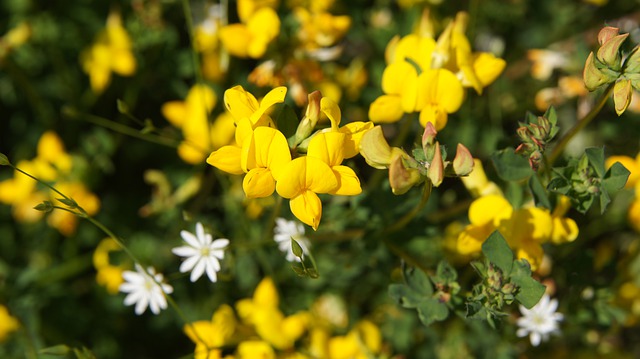 |  |  |  |  |
 |  |
Common Bird’s-foot-trefoil grows up to 50 cm, while its root grows up to 1.5 m in the ground, so this perennial plant tolerates dry weather well. The plant can grow in dry soil. The root system is strongly branched, strong, up to 2 cm in diameter. The stems form a dense rosette, up to 250 shoots can form per bush over the years. The leaves are trilobed, made of inverted oval leaflets, which are up to 12mm in length and up to 10mm in width. The flowers are small, bisexual, bright yellow, often with orange petals, arranged in 5-6 flower clusters. Fruit a linear, glabrous bean, curved with a hook. Seeds are more often round, brown or dark brown, small up to 2 mm.
The above-ground part of the plant is harvested for medicinal purposes. It is dried in well-ventilated rooms or in the fresh air, in the shade. It is preferable to harvest the plant in June, then its medicinal properties will be most pronounced. The drug is stored for up to 2 years.
The chemical composition of common Bird’s-foot-trefoil is directly related to the time of its collection. The pods, which are harvested before flowering, contain 20-30% protein, <28% fiber, 35% vegetable fat and 24% non-nitrogen extractives. During flowering, the toxic cyanogenic glycoside, which separates hydrocyanic acid, was added to the already named composition. It gives the plant a bitter taste. Until flowering, the leaves also contain carotene and ascorbic acid. The seeds contain up to 7% vegetable fat, as well as saccharides - glucose, fructose, galactose and mannose.
Medicinal significance
Common Bird’s-foot-trefoil contains flavonoids and nitrolosides, which are associated with the plant's sedative and antispasmodic properties. Vitamin C and carotenoids give the plant a wound-healing and body-strengthening effect. It's also good to know that none of these effects are scientifically proven and that you take the risk yourself when using this plant.
In folk medicine, common Bird’s-foot-trefoil is used as an expectorant, anti-inflammatory, pain-relieving, softening, calming, body-strengthening agent. Folk scientists recommend using the decoction and infusions for rinsing the mouth and throat to treat colds.
The plant has lactation-enhancing properties, but due to the possible toxicity of the plant, it is better not to use this property to increase the amount of milk! However, you should know that if you want to stop breastfeeding, then the effect of this herb may conflict with your plans.
The flower arrangement is drunk in case of severe fatigue, headache and insomnia. Applications of crushed leaves are placed on bruises, inflammations, thickenings to get rid of pain and swelling.
